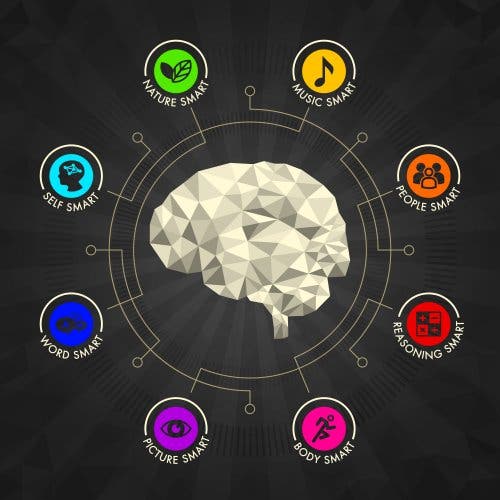How to Work Multiple Intelligences in the Classroom


Written and verified by the teacher Azucena Fernández
According to the theory of multiple intelligences, there are eight connected intelligences that use different areas of the brain. In this article, we’ll talk a little bit about multiple intelligences and see how teachers can work on them in the classroom.
These intelligences are connected to each other. Nevertheless, they can be worked on individually. Thus, the theory, instead of considering that intelligence is dominated by a single general ability, ensures that intelligence is divided into specific modalities.
Howard Gardner proposed this theory in his book Frames of Mind (1983). Gardner claims that intelligence must meet eight criteria: musical-rhythmic, visual-spatial, verbal-linguistic, logical-mathematical, bodily-kinesthetic, interpersonal, intrapersonal, and naturalistic.
What makes the theory of multiple intelligences so useful in a classroom is that it’s a theory teachers can use in any subject and level. Each student has developed a different type of intelligence throughout their lives. Therefore, everyone will be able to develop the rest and enhance the one they’ve worked on.
Today, we’re going to see the foundation for working multiple intelligences in the classroom and discover some resources to understand them better and develop them with students.
Multiple intelligences in the classroom
Bodily-kinesthetic
This type of intelligence includes all body movement skills, from sports to dance. It’s about using the body as a tool for self-expression. It’s developed through bodily experimentation. Teachers can enhance it in their students by allowing them to:
- Work on body expression in the classroom.
- Do body memory work.
- Play sports.
- Doing drama/theater exercises in class.

Verbal-linguistic
This intelligence attends more to the meaning of words and the ability to speak or write. In other words, it attends to each word, how it sounds, its rhythm, and how to use it. Teachers can develop this verbal intelligence with the following class exercises:
- Readings, either at home or individually, recommending a specific book, or as a group.
- Individual creative writing.
- Class discussions on a specific topic.
Visual/spatial
The intelligence that allows us to observe the space around us, the forms of things, and the ability to orient ourselves.
“Features the potential to recognize and manipulate the patterns of wide space (those used, for example, by navigators and pilots) as well as the patterns for more confined areas (such as those of importance to sculptors, surgeons, chess players, graphic artists, or architects).”
– Howard Gardner –
It’s possible to enhance it in class in different ways:
- Include graphic content, tables, illustrations, maps, and visual data in tasks whenever possible.
- Allow students to practice drawing or design creation on paper. You can even allow them to spend time practicing photography.
- Create murals, infographics, and visual presentations.
Musical-rhythmic intelligence
It’s the ability to sing and know the tones, the rhythm, and the pulse. The sensitivity to understand music, tuning, and musical expression. Therefore, you can work on it by allowing students to:
- Actively listen to music, for example, in a guided way.
- Sing alone and in groups, learning to tune and refine.
- Discover new musical instruments and learn to differentiate them.
- Enjoy musical games.
- Go to educational concerts.
Logical/mathematical
This intelligence enables people to understand numbers, mathematics, develop abstract concepts, and reason. As a result, teachers can develop it in the following ways, by allowing their students to:
- Perform calculations and solve problems in class.
- Do theoretical experiments that allow them to reason with numbers.
- Solve puzzles, riddles, and logic games.
Intrapersonal, one of the multiple intelligences to work on in the classroom
This is the ability to know yourself and be aware of your own feelings. It consists of understanding who you are objectively and, in addition, understanding your inner states of mind and motivations. In this sense, self-esteem is a fundamental part of this intelligence.

To work on it in the classroom, teachers can allow students to:
- Conduct a directed self-assessment.
- Focus on personal organization while working.
- Create a diary in which they define themselves little by little.
Interpersonal, another of the multiple intelligences to work on in the classroom
This intelligence gives you sensitivity and, therefore, the ability to understand other people and their feelings. Thus, empathy, the ability to relate and interact, and leadership stem from this intelligence. You can enhance it in various ways:
- Create discussion groups in the classroom and make the students, in addition to debating within their group, also do so with other groups.
- Group work is essential to develop interpersonal intelligence.
- A good idea is to play a movie and then debate with the students regarding what they’ve seen.
Naturalistic
It’s the ability to understand the natural world. You can develop it by observing the natural environment that surrounds them and thinking about it. On the other hand, you can also boost it by exploring. You can work on this by allowing students to:
- Do activities in a natural environment.
- Visit nature interpretation centers.
- Go on field trips.
In conclusion, in their day-to-day classroom life, it’s possible for teachers to create learning programs based on the development of multiple intelligences. They should use a transversal form, thus incorporating these methods in any subject matter.
According to the theory of multiple intelligences, there are eight connected intelligences that use different areas of the brain. In this article, we’ll talk a little bit about multiple intelligences and see how teachers can work on them in the classroom.
These intelligences are connected to each other. Nevertheless, they can be worked on individually. Thus, the theory, instead of considering that intelligence is dominated by a single general ability, ensures that intelligence is divided into specific modalities.
Howard Gardner proposed this theory in his book Frames of Mind (1983). Gardner claims that intelligence must meet eight criteria: musical-rhythmic, visual-spatial, verbal-linguistic, logical-mathematical, bodily-kinesthetic, interpersonal, intrapersonal, and naturalistic.
What makes the theory of multiple intelligences so useful in a classroom is that it’s a theory teachers can use in any subject and level. Each student has developed a different type of intelligence throughout their lives. Therefore, everyone will be able to develop the rest and enhance the one they’ve worked on.
Today, we’re going to see the foundation for working multiple intelligences in the classroom and discover some resources to understand them better and develop them with students.
Multiple intelligences in the classroom
Bodily-kinesthetic
This type of intelligence includes all body movement skills, from sports to dance. It’s about using the body as a tool for self-expression. It’s developed through bodily experimentation. Teachers can enhance it in their students by allowing them to:
- Work on body expression in the classroom.
- Do body memory work.
- Play sports.
- Doing drama/theater exercises in class.

Verbal-linguistic
This intelligence attends more to the meaning of words and the ability to speak or write. In other words, it attends to each word, how it sounds, its rhythm, and how to use it. Teachers can develop this verbal intelligence with the following class exercises:
- Readings, either at home or individually, recommending a specific book, or as a group.
- Individual creative writing.
- Class discussions on a specific topic.
Visual/spatial
The intelligence that allows us to observe the space around us, the forms of things, and the ability to orient ourselves.
“Features the potential to recognize and manipulate the patterns of wide space (those used, for example, by navigators and pilots) as well as the patterns for more confined areas (such as those of importance to sculptors, surgeons, chess players, graphic artists, or architects).”
– Howard Gardner –
It’s possible to enhance it in class in different ways:
- Include graphic content, tables, illustrations, maps, and visual data in tasks whenever possible.
- Allow students to practice drawing or design creation on paper. You can even allow them to spend time practicing photography.
- Create murals, infographics, and visual presentations.
Musical-rhythmic intelligence
It’s the ability to sing and know the tones, the rhythm, and the pulse. The sensitivity to understand music, tuning, and musical expression. Therefore, you can work on it by allowing students to:
- Actively listen to music, for example, in a guided way.
- Sing alone and in groups, learning to tune and refine.
- Discover new musical instruments and learn to differentiate them.
- Enjoy musical games.
- Go to educational concerts.
Logical/mathematical
This intelligence enables people to understand numbers, mathematics, develop abstract concepts, and reason. As a result, teachers can develop it in the following ways, by allowing their students to:
- Perform calculations and solve problems in class.
- Do theoretical experiments that allow them to reason with numbers.
- Solve puzzles, riddles, and logic games.
Intrapersonal, one of the multiple intelligences to work on in the classroom
This is the ability to know yourself and be aware of your own feelings. It consists of understanding who you are objectively and, in addition, understanding your inner states of mind and motivations. In this sense, self-esteem is a fundamental part of this intelligence.

To work on it in the classroom, teachers can allow students to:
- Conduct a directed self-assessment.
- Focus on personal organization while working.
- Create a diary in which they define themselves little by little.
Interpersonal, another of the multiple intelligences to work on in the classroom
This intelligence gives you sensitivity and, therefore, the ability to understand other people and their feelings. Thus, empathy, the ability to relate and interact, and leadership stem from this intelligence. You can enhance it in various ways:
- Create discussion groups in the classroom and make the students, in addition to debating within their group, also do so with other groups.
- Group work is essential to develop interpersonal intelligence.
- A good idea is to play a movie and then debate with the students regarding what they’ve seen.
Naturalistic
It’s the ability to understand the natural world. You can develop it by observing the natural environment that surrounds them and thinking about it. On the other hand, you can also boost it by exploring. You can work on this by allowing students to:
- Do activities in a natural environment.
- Visit nature interpretation centers.
- Go on field trips.
In conclusion, in their day-to-day classroom life, it’s possible for teachers to create learning programs based on the development of multiple intelligences. They should use a transversal form, thus incorporating these methods in any subject matter.
All cited sources were thoroughly reviewed by our team to ensure their quality, reliability, currency, and validity. The bibliography of this article was considered reliable and of academic or scientific accuracy.
- Howard Gardner. Frames of Mind:The Theory of Multiple Intelligences. 1983.
This text is provided for informational purposes only and does not replace consultation with a professional. If in doubt, consult your specialist.








